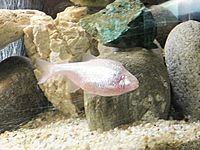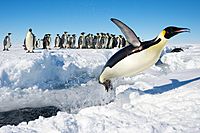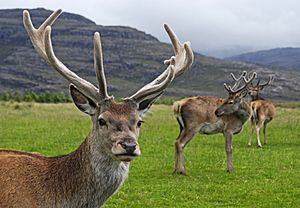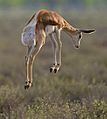Adaptation facts for kids
Adaptation is the process in which an organism becomes better able to live in its habitat. This process takes place over many generations. It is one of the basic phenomena of biology.
When people speak about adaptation, they often mean a 'feature' (a trait) which helps an animal or plant survive. The picture of bird beaks shows an obvious sign of their different ways of life. However, eating a different food also means having a different digestive system, gut, claws, wings, and inherited behavior. For the major adaptations, what changes is not a single trait, but a whole group of features.
Adaptation occurs because the better-adapted animals are the most likely to survive and reproduce successfully. This process is known as natural selection.
Contents
Role in environment
All adaptations help organisms survive in their ecological niches (environments). These adaptive traits may be structural, behavioral, or physiological.
- Structural adaptations are the physical features of an organism, like its shape, body covering, and internal parts. It can also include physical skills like camouflage and mimicry.
- Behavioral adaptations include inherited instincts (like hibernation or migration) or the ability to learn.
- Physiological adaptations allow the organism to do special things like making venom, secreting slime, phototropism, using echolocation, regulating temperature, and other characteristics of homeostasis.

Woodpecker adaptations are a good example of how a whole group of features is needed for a successful way of life:
- The bill is chisel-like and self-sharpening. The bird uses it to get at grubs under the bark, to widen a hole to make a nest, and to signal its territory by drumming.
- Long sticky tongues are used to grab insect grubs that live under the bark.
- The millisecond before a woodpecker's beak contacts the wood, a thickened nictitating membrane closes, protecting its eye from flying debris. The nostrils are also protected. They are small slits that are covered with feathers.
- A woodpecker's brain is small and held in the skull with spongy plates that absorb shock, protecting it from brain damage. The upper part of the beak is shorter, which directs the impact force downward and away from the small brain. Woodpeckers have a special hyoid bone, which reaches from their beak and loops over the top of the skull to surround their brains. This acts to keep the brain in place.
- Woodpeckers have zygodactyl feet. These feet have four toes, the first and the fourth face backward, and the second and third face forward. This foot arrangement is good for grasping the limbs and trunks of trees. Woodpeckers can walk vertically up a tree trunk.
- The tails of woodpeckers are stiffened, helping them perch well on vertical surfaces.
Functions of adaptations
Traits with no function
Not all features of an organism are adaptations, but some adaptations tend to reflect the past life of a species. For instance, animals that live in dark caves often lose, over a long period, their colors and eyesight, but they still have eyes. Another example is that the wings of a penguin may have been used for flight. Scientists believe that adaptations that are no longer useful either become vestigial organs (see vermiform appendix) or are changed to perform a different function (see ear ossicles).
Adaptations with multiple functions
Many adaptations serve more than one function. This is often why some traits become so noticeable that they almost define the species concerned.
The legs of a horse are also a main defense: a horse's kick is very destructive. The antlers of male deer serve a sexual function as well as a defense against predators.
Man's large brain serves not only for language but also for thinking and problem-solving.
Bird feathers are not just used to fly; they are also used for heat conservation, temperature regulation, and signaling.
Interesting facts about adaptation
- Honeybees have several amazing adaptations: they can communicate the location of nectar to other bees through performing a dance, they can sense the earth's magnetic field, and they can detect electromagnetic waves in the atmosphere that predict thunderstorms on the way!
- African bullfrogs create homes out of mucus to survive the dry season.
- Roadrunners, kangaroo rats, and some gazelles can survive their whole lives without ever taking one sip of water. They get the water they need from their food.
- Peacock flounders can change their patterns and colors to match their surroundings in the ocean, often within minutes.
- Alaskan wood frogs stop breathing and their hearts stop beating when their bodies freeze solid in the winter. This allows them to survive temperatures as low as -80 degrees Fahrenheit.
- Lungless salamanders breathe through their skin, absorbing oxygen from the surrounding air.
- The horned lizard, also known as the horny toad, shoots blood from its eyes when confronted by predators.
- The opossum can play dead to make predators go away. They can also resist snake venom.
Related pages
Images for kids
-
Some generalists, such as birds, have the flexibility to adapt to urban areas.
-
Images A and B show real wasps; the others show Batesian mimics: three hoverflies and one beetle.
-
An Indian peacock's train in full display
-
The feathers of Sinosauropteryx, a dinosaur with feathers, were used for insulation, making them an exaptation for flight.
See also
 In Spanish: Adaptación biológica para niños
In Spanish: Adaptación biológica para niños














